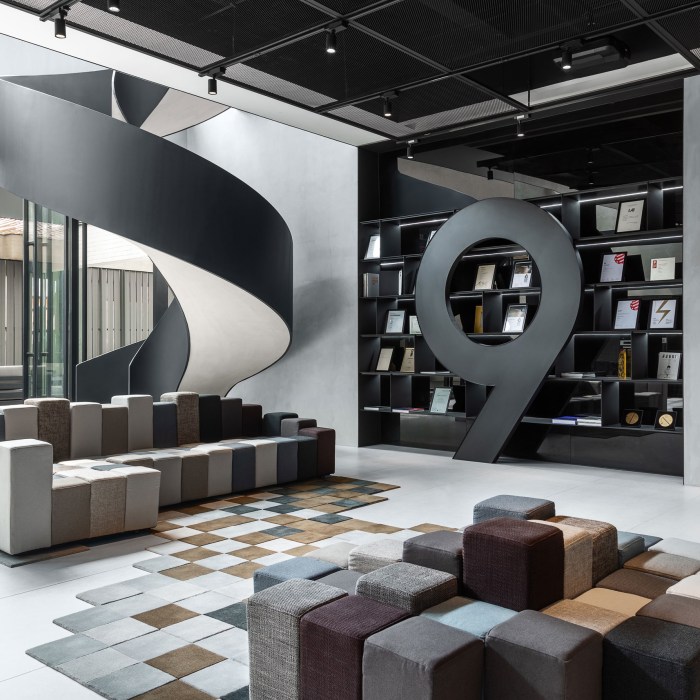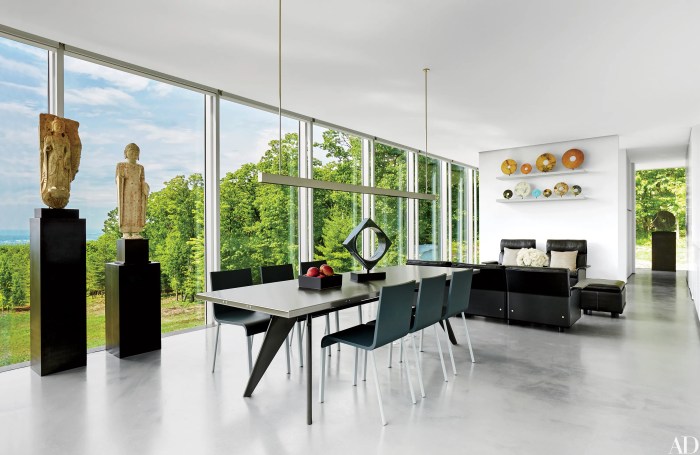Exploring the World of Interior Design Architecture

Step into the realm of interior design architecture, where creativity meets functionality in a harmonious blend. From iconic structures to innovative designs, this topic delves into the fascinating intersection of interior design and architecture, offering a glimpse into a world where spaces come alive with purpose and style.
Introduction to Interior Design Architecture
Interior design architecture is the art and science of enhancing the interior of a building to achieve a healthier and more aesthetically pleasing environment for the people using the space. It involves the planning, designing, and coordination of interior spaces.
The relationship between interior design and architecture is closely intertwined, as both disciplines work together to create spaces that are not only functional but also visually appealing. While architecture focuses on the overall structure and exterior of a building, interior design architecture deals with the interior layout, furniture, colors, textures, and lighting that make up the inside of a space.
Examples of Famous Interior Design Architectural Projects
- The Guggenheim Museum in New York City, designed by Frank Lloyd Wright, is a prime example of how interior design architecture can create a seamless blend of art and space.
- The Burj Khalifa in Dubai, designed by Skidmore, Owings & Merrill, showcases how interior design architecture can create luxurious and functional living spaces within a towering skyscraper.
- The Palace of Versailles in France, with its ornate interiors and intricate details, is a historical example of interior design architecture that has stood the test of time.
Principles of Interior Design Architecture
Interior design architecture is guided by several key principles that help create functional, visually appealing spaces. These principles include considerations of form, function, and aesthetics, each playing a crucial role in the design process.
Form
Form in interior design architecture refers to the shape, structure, and composition of the space. It involves elements such as line, shape, texture, and color that come together to create a cohesive and harmonious design. Form ensures that the space is visually pleasing and serves its intended purpose effectively.
Function
Functionality is another essential principle in interior design architecture. It focuses on how the space will be used and ensures that the design meets the needs of its occupants. Functionality considers factors such as traffic flow, ergonomics, and spatial organization to optimize the usability of the space.
Aesthetics
Aesthetics play a significant role in interior design architecture by enhancing the visual appeal of the space. It involves the careful selection of materials, finishes, furniture, and decor to create a cohesive and pleasing environment. Aesthetic considerations also encompass elements like balance, proportion, and harmony to create a visually stunning design.
Traditional vs. Modern Approaches
Traditional interior design architecture often emphasizes intricate details, ornate decorations, and rich textures. It draws inspiration from classic design styles and historical periods to create timeless and elegant spaces. In contrast, modern interior design architecture focuses on simplicity, minimalism, and clean lines.
It prioritizes functionality and efficiency while incorporating contemporary materials and technologies for a sleek and sophisticated look.
Elements of Interior Design Architecture
When it comes to interior design architecture, several key elements play a crucial role in creating a harmonious and functional space. These elements work together to enhance the overall aesthetic appeal and functionality of a building's interior.
Lighting
Lighting is a fundamental element in interior design architecture as it can greatly impact the mood and ambiance of a space. Proper lighting can highlight architectural features, create focal points, and enhance the overall design scheme. Whether it's natural light streaming through windows or strategically placed artificial lighting fixtures, the right lighting can transform a room's atmosphere.
Color
Color plays a significant role in interior design architecture by setting the tone and creating a visual impact. Different colors evoke different emotions and can influence how a space is perceived. Whether it's bold and vibrant hues or subtle and neutral tones, the choice of colors can greatly affect the overall look and feel of a room.
Texture
Texture adds depth and dimension to interior design architecture. By incorporating a variety of textures such as smooth surfaces, rough finishes, soft fabrics, or tactile materials, designers can create visual interest and tactile appeal. Texture not only enhances the aesthetics of a space but also adds a sense of richness and warmth.
Space
Space planning is a critical element in interior design architecture as it involves the arrangement of furniture, circulation paths, and functional zones within a room. Proper space planning ensures that the space is utilized efficiently and that there is a seamless flow between different areas.
Whether it's an open-concept layout or a more compartmentalized design, the effective use of space is essential in creating a functional and comfortable environment.
Furniture and Decor
Furniture and decor play a vital role in enhancing architectural designs by adding personality and style to a space. The choice of furniture pieces, accessories, and decorative elements can complement the overall design concept and tie the room together. From statement furniture pieces to curated decor items, these elements help to bring the design vision to life and create a cohesive look.
Sustainable Practices in Interior Design Architecture

In today's world, sustainable practices in interior design architecture have become increasingly important as we strive to reduce our environmental footprint and create healthier living spaces. By incorporating eco-friendly materials and technologies, designers can not only minimize the impact on the environment but also enhance the functionality and aesthetics of interior spaces.
Examples of Eco-Friendly Materials and Technologies
- Bamboo: A renewable resource that is durable and versatile, commonly used for flooring, furniture, and decor.
- Recycled Glass: Used in countertops, tiles, and decorative accents, reducing waste and energy consumption.
- Solar Panels: Harnessing renewable energy to power interior lighting and appliances, reducing reliance on non-renewable sources.
- Low VOC Paints: Volatile organic compound-free paints that improve indoor air quality and reduce health risks.
Impact of Sustainable Design on Interior Spaces
Implementing sustainable design practices can greatly impact the overall functionality and aesthetics of interior spaces. By using natural materials and energy-efficient technologies, designers can create healthier environments that promote well-being and productivity. Additionally, sustainable design can enhance the visual appeal of spaces, incorporating elements of nature and eco-conscious design principles for a more harmonious and inviting atmosphere.
Cultural Influences on Interior Design Architecture

Cultural influences play a significant role in shaping interior design architectural styles. Different cultures bring unique perspectives, traditions, and aesthetics that impact the design of spaces. Historical events also leave a mark on architectural choices, reflecting the values and beliefs of a society.
Embracing cultural diversity in interior design architecture leads to the creation of truly distinctive and meaningful spaces.
Impact of Cultural Diversity
Cultural diversity enriches interior design architecture by infusing spaces with a variety of influences, styles, and materials. By incorporating elements from different cultures, designers can create environments that are not only visually stunning but also reflective of the global interconnectedness of our world.
This approach allows for the celebration of traditions and heritage, fostering a sense of inclusivity and appreciation for cultural richness.
Historical Events and Architectural Choices
Historical events such as wars, revolutions, and social movements have had a profound impact on interior design architecture. These events often lead to shifts in design preferences, materials used, and overall aesthetics. For example, the Bauhaus movement emerged as a response to the aftermath of World War I, emphasizing simplicity, functionality, and minimalism in design.
Understanding the historical context behind architectural choices provides insight into the evolution of interior design styles over time.
Cultural Symbols and Design Elements
Symbols and design elements rooted in specific cultures can be integrated into interior design architecture to convey meaning and evoke emotional responses. For instance, the use of traditional patterns, colors, and motifs from a particular culture can create a sense of connection and identity within a space.
By incorporating these cultural symbols thoughtfully, designers can establish a narrative that resonates with inhabitants and visitors alike, fostering a deeper appreciation for cultural heritage.
Final Thoughts
As we conclude this exploration of interior design architecture, we are reminded of the intricate dance between form and function, tradition and innovation. From sustainable practices to cultural influences, each element contributes to the rich tapestry of architectural design, shaping the way we experience and interact with the spaces around us.
Answers to Common Questions
How are lighting, color, texture, and space utilized in interior design architecture?
Lighting sets the mood, color adds personality, texture creates depth, and space defines functionality in interior design architecture.
What is the impact of sustainable design on interior spaces?
Sustainable design enhances the functionality and aesthetics of interior spaces by promoting eco-friendly materials and technologies.
How do different cultures influence interior design architectural styles?
Different cultures infuse unique elements into architectural styles, reflecting diverse traditions and aesthetics in interior design.

